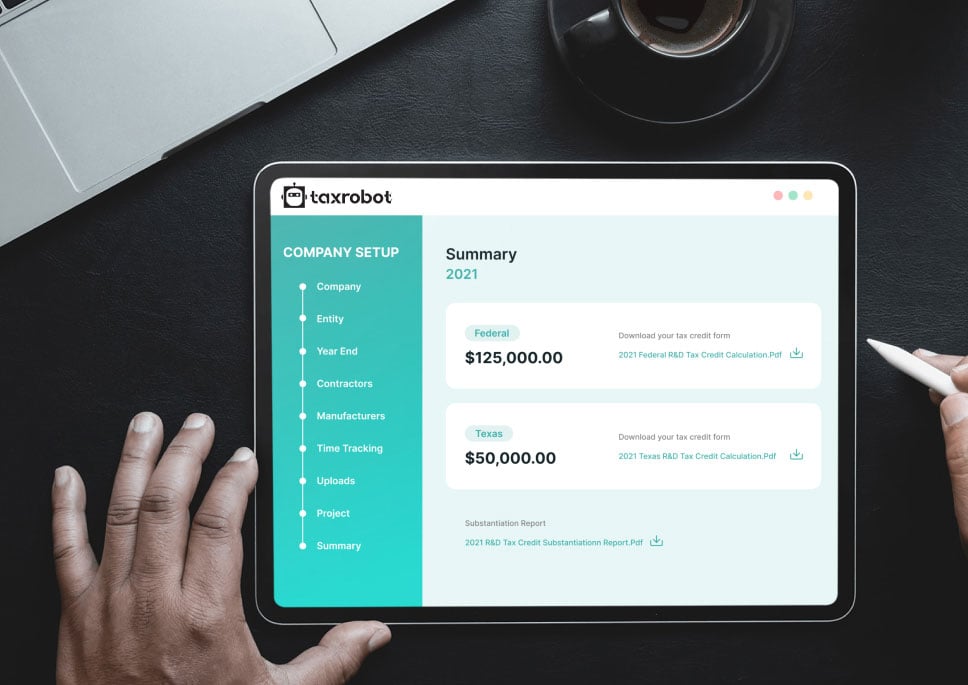Mississippi R&D Tax Credit
With TaxRobot, Mississippi R&D Tax Credit becomes more than a benefit—it becomes a catalyst for your business growth. Unleashing the incredible, simplifying the complex. This is not just tax planning; it’s financial evolution.
Maximize your State Credits today!
Put the R&D tax credit process on autopilot.
Trusted By:








Mississippi R&D Tax Credit
Discover your eligibility for Mississippi R&D tax credits and supercharge your enterprise.
Simplify and Maximize Your Mississippi R&D Tax Credit with TaxRobot
Welcome to TaxRobot, your trusted partner in simplifying the process of claiming R&D tax credits in Mississippi. Our AI-powered software is designed to simplify your life, providing faster calculations, maximum refunds, and an intuitive platform.
With our team of subject matter experts, we have delivered substantial refunds to clients nationwide, and we’re here to do the same for you.
Say goodbye to the hassle of manual calculations and let TaxRobot streamline your R&D tax credit process.
Mississippi R&D Tax Credits and Federal Research and Development (R&D) Tax Credit
In Mississippi, while state-level R&D tax credits are unavailable, businesses operating within the state can still tap into the significant benefits of the Federal Research and Development (R&D) Tax Credit.
This federal program is crucial in providing financial support to companies actively involved in qualifying research activities, fueling innovation, and fostering growth.
Federal R&D Tax Credit Eligibility
The Federal R&D Tax Credit operates under a four-part test that determines eligibility.
- The activities must be technological, relying on principles from physical or biological sciences, engineering, or computer science.
- They should serve a permitted purpose, aiming to improve a new or existing business component’s functionality, performance, reliability, or quality.
- These activities must seek to eliminate uncertainty by discovering information that will overcome technical uncertainties related to product development or improvement.
- The process of experimentation must be present, involving testing, modeling, simulating, and systematic trial and error.
Research and Development (R&D) Skills Tax Credit in Mississippi
In addition to the Federal R&D Tax Credit, Mississippi offers another enticing benefit for businesses investing in research and development: the Research and Development (R&D) Skills Tax Credit.
This credit provides an annual $1,000 credit per employee for five years, specifically targeting new full-time positions that require research skills.
Businesses must follow a straightforward application process to take advantage of this credit. It involves submitting a request letter to the Department of Revenue and providing essential employee information such as job titles, educational requirements, experience qualifications, hours worked, compensation, and hiring dates.
It’s important to note that the R&D Skills Tax Credit utilization is limited to 50% of the annual income tax liability. Any unused credits can be carried forward for up to five years, allowing businesses to maximize the benefits of this valuable incentive.
By leveraging the Research and Development (R&D) Skills Tax Credit, businesses in Mississippi can further augment their research efforts, foster a skilled workforce, and amplify the impact of their R&D investments.
Benefits of Choosing TaxRobot for Mississippi R&D Tax Credits
When claiming R&D tax credits in Mississippi, choosing TaxRobot brings many benefits that set us apart from competing consultants and software products. With TaxRobot by your side, you can expect bigger refunds that go above and beyond what others offer.
Our advanced algorithms streamline the calculation process and save you valuable time. By automating complex calculations and documentation, we enable you to shift your focus back to your core business operations, eliminating the need for tedious manual work.
Additionally, TaxRobot provides comprehensive audit support. In the event of an audit, our team stands ready to assist you, addressing any inquiries and ensuring a smooth process. We understand the importance of expert guidance during these critical moments, and we’re dedicated to being your trusted partner throughout the entire R&D tax credit journey.
Get Started Today With TaxRobot!
TaxRobot is your trusted partner in simplifying the process of claiming R&D tax credits in Mississippi. With our AI-powered software, you can expect faster calculations, maximum refunds, and an intuitive platform that saves you time and effort.
Our team of experts is dedicated to delivering bigger refunds compared to competitors. We provide audit support, ensuring a seamless experience in case of an audit. Let TaxRobot handle the complexities while you focus on driving innovation and growing your business.
Take a sneak peak

- Limited Time Offer
- Simple Onboarding
- Easy to Use
R&D Tax Credits FAQs
The four-part test as outlined in the Internal Revenue Code is used to determine qualified R&D activity.
The Four-Part Test
1). New Or Improved Business Component
Creation of a new product, process, formula, invention, software, or technique; or improving the performance, functionality, quality, or reliability of existing business component.
- Construction of new buildings or renovation of existing buildings
- Invention of a software application
- Manufacturing of a new product or the improvement of the production process for an existing product
- Creation of design documentation
2). Technological In Nature
The activity fundamentally relies on principles of the physical or biological sciences, engineering, or computer science. A taxpayer does not need to obtain information that exceeds, expands or refines the common knowledge of skilled professionals in a particular field.
- Physics (relationship between mass, density and volume; loading as the
result of gravitational attraction) - Engineering (mechanical, electrical, civil, chemical)
- Computer science (theory of computation and design of computational systems)
3). Elimination Of Uncertainty
Uncertainty exists if the information available to the taxpayer does not establish the capability or method for developing or improving the business component, or the appropriate design of the business component.
- The capability of a manufacturer to create a part within the specified tolerances
- The appropriate method of overcoming unsuitable soil conditions during construction
- The appropriate software design to meet quality and volatility requirements
4). Process Of Experimentation
A process designed to evaluate one or more alternatives to achieve a result where the capability or method of achieving that result, or the appropriate design of that result, is uncertain as of the beginning of the taxpayer’s research activities.
- Systematic process of trial and error
- Evaluating alternative means and methods
- Computer modeling or simulation Prototyping Testing
The R&D tax credit is one of the most misunderstood tax incentives available. Considering the myriad of industries and activities that legally qualify for the credit, the term “research and development” is a misnomer. Additionally, the R&D tax credit requires specialized knowledge and technology to identify and calculate the incentive properly.
Companies of various industries are unaware that they are eligible to claim the R&D tax credit. Under the Internal Revenue Code’s definition of R&D, many common activities qualify. You can get tax benefits for industries including software, technology, architecture, engineering, construction, manufacturing, and more.
The R&D tax credit can be claimed for all open tax years. Generally, open tax years include the prior three tax years due to the statute of limitations period. In certain circumstances, the law allows businesses to claim the R&D tax credit for an extended period of time. It is common for companies to amend previous tax years to claim this benefit and reduce the maximum amount of tax liability.
Partnerships and S corporations must file this form to claim the credit. The credit will flow from the Form 6765, to the Schedule K-1, to the Form 3800 on the individual’s tax return. For individuals receiving this credit that have ownership interest in a partnership or S corporation, Form 6765 is not required on the individual return.
Individuals claiming this credit can report the credit directly on Form 3800, General Business Credit if their only source for the credit is a partnership, S corporation, estate, or trust. Otherwise, Form 6765 must be filed with the individual’s tax return (e.g. sole proprietorship).
For tax years prior to 2016, the credit can be used to reduce the taxpayer’s regular tax liability down to the tentative minimum tax. The credit cannot be used to offset alternative minimum tax. Beginning in tax year 2016, eligible small businesses have expanded utilization for the credit. For these eligible small businesses, the regular tax liability can offset alternative minimum tax using the “25/25” rule.
What our customers have to say
I highly recommend TaxRobot to anyone considering an R&D Tax Credit software to complete their analysis.

We decided to switch to TaxRobot… Best decision we’ve ever made. More affordable, and less complicated.

I couldn’t believe how easy it was! In under an hour, we saved enough money to hire a new employee.
